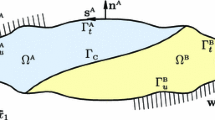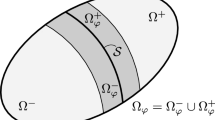Abstract
The problem of quasistatic and rate-independent evolution of elastic-plastic-brittle delamination at small strains is considered. Delamination processes for linear elastic bodies glued by an adhesive to each other or to a rigid outer surface are studied. The energy amounts dissipated in fracture Mode I (opening) and Mode II (shear) at an interface may be different. A concept of internal parameters is used here on the delaminating interfaces, involving a couple of scalar damage variable and a plastic tangential slip with kinematic-type hardening. The so-called energetic solution concept is employed. An inelastic process at an interface is devised in such a way that the dissipated energy depends only on the rates of internal parameters and therefore the model is associative. A fully implicit time discretization is combined with a spatial discretization of elastic bodies by the BEM to solve the delamination problem. The BEM is used in the solution of the respective boundary value problems, for each subdomain separately, to compute the corresponding total potential energy. Sample problems are analysed by a collocation BEM code to illustrate the capabilities of the numerical procedure developed.




















Similar content being viewed by others
References
Banks-Sills L, Ashkenazi D (2000) A note on fracture criteria for interface fracture. Int J Frac 103:177–188
Bažant Z, Jirásek M (2002) Nonlocal integral formulations of plasticity and damage: survey of progress. J Eng Mech 128(11):1119–1149
Benešová B (2009) Modeling of shape-memory alloys on the mesoscopic level. In: Šittner P et al. (ed) Proc. ESOMAT 2009, EDP Sciences, 03003, pp 1–7
Benešová B (2011) Global optimization numerical strategies for rate-independent processes. J Global Optim 50:197–220
Biot MA (1956) Thermoelasticity and irreversible thermodynamics. J Appl Phys 27:240–253
Biot MA (1965) Mechanics of incremental deformations. Wiley, New York
Bourdin B, Francfort GA, Marigo JJ (2000) Numerical experiments in revisited brittle fracture. J Mech Phys Solids 48:797–826
Byrd RH, Lu P, Nocedal J, Zhu C (1994) A limited memory algorithm for bound constrained optimization. SIAM J Sci Comput 16:1190–1208
Carpinteri A, Cornetti P, Pugno N (2009) Edge debonding in FRP strengthened beams: stress versus energy failure criteria. Eng Struct 31:2436–2447
Cornetti P, Carpinteri A (2011) Modelling the FRP-concrete delamination by means of an exponential softening law. Eng Struct 33:1988–2001
Dostál Z (2009) Optimal quadratic programming algorithms: with applications to variational inequalities. Springer, New York
Evans A, Rühle M, Dalgleish B, Charalambides P (1990) The fracture energy of bimaterial interfaces. Metall Trans A 21A: 2419–2429
Figueiredo MAT, Nowak RD, Wright SJ (2008) Gradient projection for sparse reconstruction: application to compressed sensing and other inverse problems. IEEE J Selected Topics Signal Process 1:586–597
Frémond M (1985) Dissipation dans l’adherence des solides. C.R. Acad Sci, Paris, Sér.II 300(15):709–714
Griffith A (1921) The phenomena of rupture and flow in solids. Philos Trans Royal Soc London Ser A Math Phys Eng Sci 221:163–198
Han W, Reddy BD (1999) Plasticity: Mathematical theory and numerical analysis. Springer, New York
Hartmann F (1989) Introduction to boundary elements theory and applications. Springer, Berlin
Hui CY, Ruina A, Long R, Jagota A (2011) Cohesive zone models and fracture. J Adhes 87:1–52
Hutchinson JW, Suo Z (1992) Mixed mode cracking in layered materials. Adv Appl Mech 29:63–191
Khoromskij BN, Wittum G (2004) Numerical solution of elliptic differential equations by reduction to the interface. Springer, Berlin
Kolluri M, Thissen M, Hoefnagels J, van Dommelen J, Geers M (2009) In-situ characterization of interface delamination by a new miniature mixed mode bending setup. Int J Fract 158:183–195
Kočvara M, Mielke A, Roubíček T (2006) A rate-independent approach to the delamination problem. Math Mech Solids 11: 423–447
Lenci A (2001) Analysis of a crack at a weak interface. Int J Fract 108:275–290
Liechti K, Chai Y (1992) Asymmetric shielding in interfacial fracture under in-plane shear. J Appl Mech 59:295–304
Makhorin A (2004) GLPK-GNU linear programming Kit. Free Software Foundation, version 4.4
Mantič V (1993) A new formula for the C-matrix in the Somigliana identity. J Elast 33:191–201
Mielke A (2005) Evolution in rate-independent systems (Chap. 6). In: Dafermos C, Feireisl E(eds) Handbook of differential equations, evolutionary equations, vol 2, Elsevier B.V., Amsterdam, pp 461–559
Mielke A (2010) Differential, energetic and metric formulations for rate-independent processes. In: Ambrosio L, Savaré G (eds) Nonlinear PDEs and applications. Springer, New York, pp 87–170
Mielke A, Roubíček T (2006) Rate-independent damage processes in nonlinear elasticity. Math Models Meth Appl Sci 16:177–209
Mielke A, Roubíček T (2009) Numerical approaches to rate-independent processes and applications in inelasticity. Math Model Numer Anal (M2AN) 43, 399–428
Mielke A, Roubíček T, Zeman J (2009) Complete damage in elastic and viscoelastic media and its energetics. Comput Methods Appl Mech Eng 199:1242–1253
Mielke A, Theil F (2001) On rate-independent hysteresis models. Nonl Diff Eqns Appl (NoDEA) 11:151–189
Mielke A, Theil F, Levitas VI (2002) A variational formulation of rate-independent phase transformations using an extremum principle. Arch Rational Mech Anal 162:137–177
Panagiotopoulos CG (2010) Open BEM project. http://www.openbemproject.org/
París F, Cañas J (1997) Boundary element method fundamentals and applications. Oxford University Press, Oxford
Roubíček T, Kružík M, Zeman J (2013) Delamination and adhesive contact models and their mathematical analysis and numerical treatment. In: Mantič V, (ed) Math. Methods & Models in Composites, chap. 9. Imperial College Press, London
Roubíček T, Mantič V, Panagiotopoulos CG (2013) Quasistatic mixed-mode delamination model. Discrete and Continuous Dynamical Systems, Series S 6:591–610
Sauter SA, Schwab C (2010) Boundary element methods. Springer, Berlin
Simo J, Hughes T (1998) Computational inelasticity. Springer, New York
Távara L, Mantič V, Graciani E, Cañas J, París F (2010) Analysis of a crack in a thin adhesive layer between orthotropic materials: an application to composite interlaminar fracture toughness test. Comput Model Eng Sci (CMES) 58:247–270
Távara L, Mantič V, Graciani E, París F (2011) BEM analysis of crack onset and propagation along fiber-matrix interface under transverse tension using a linear elastic-brittle interface model. Eng Anal Boundary Elem 35:207–222
Tvergaard V, Hutchinson J (1993) The influence of plasticity on mixed mode interface toughness. J Mech Phys Solids 41: 1119–1135
Vodička R, Mantič V (2011) An energetic approach to mixed mode delamination problem - an SGBEM implementation. In: Výpočty konstrukcí metodou konečných prvk\(\mathring{\rm u}\). ISBN 978-80-261-0059-1, Západočeská univerzita v Plzni, Plzeň
Williams ML (1959) The stresses around a fault or crack in dissimilar media. Bull Seismol Soc Am 49:199–204
Acknowledgments
The support by the Junta de Andalucía and Fondo Social Europeo (Proyecto de Excelencia TEP-4051) is warmly acknowledged. VM also acknowledges the support by the Ministerio de Ciencia e Innovación (Proyecto MAT2009-14022). TR acknowledges partial support from the grants 201/09/0917, 201/10/0357, and 201/12/0671 (GA ČR), and the institutional support RVO: 67985971 (ČR).
Author information
Authors and Affiliations
Corresponding author
Rights and permissions
About this article
Cite this article
Panagiotopoulos, C.G., Mantič, V. & Roubíček, T. BEM solution of delamination problems using an interface damage and plasticity model. Comput Mech 51, 505–521 (2013). https://doi.org/10.1007/s00466-012-0826-3
Received:
Accepted:
Published:
Issue Date:
DOI: https://doi.org/10.1007/s00466-012-0826-3




